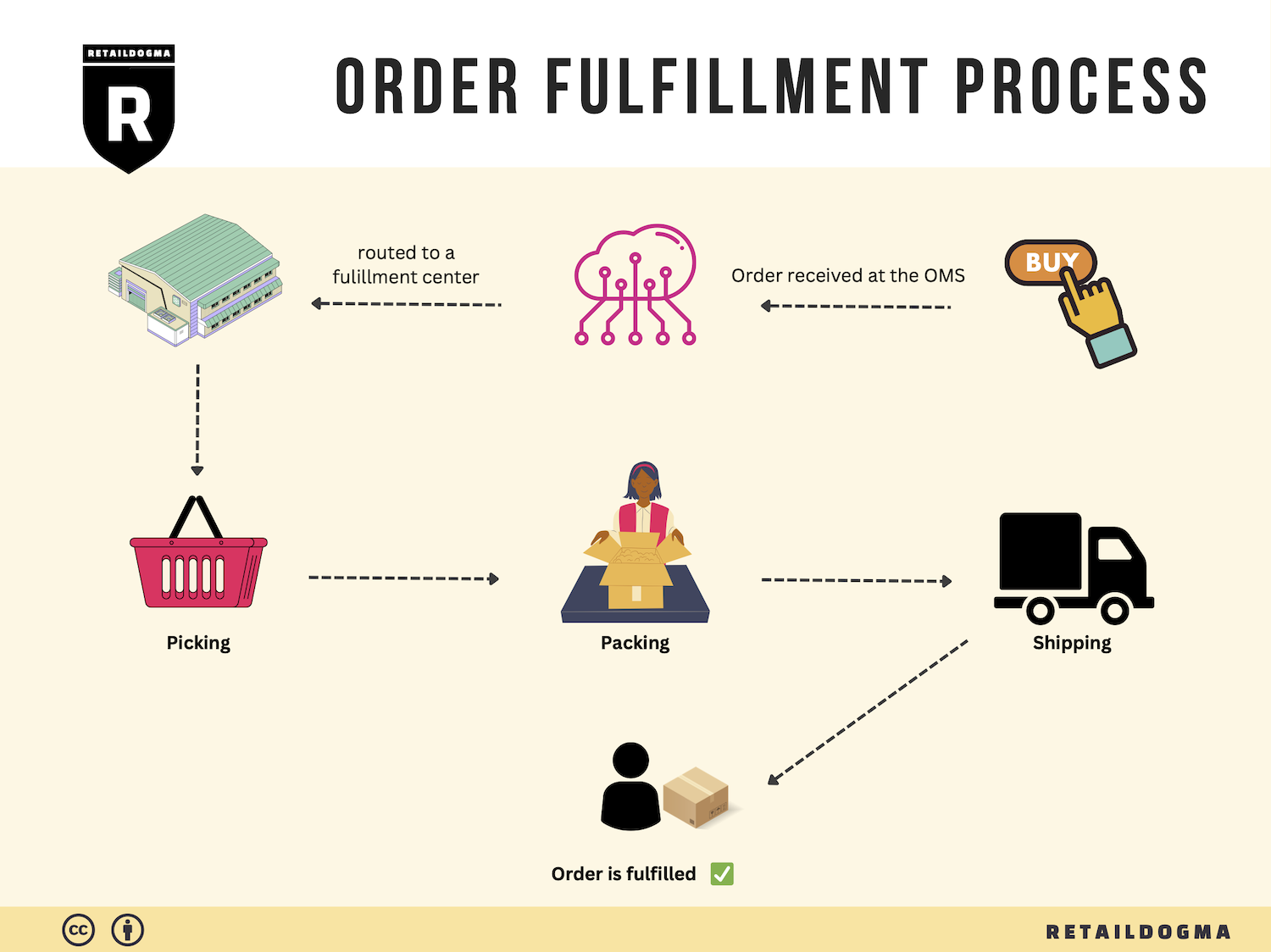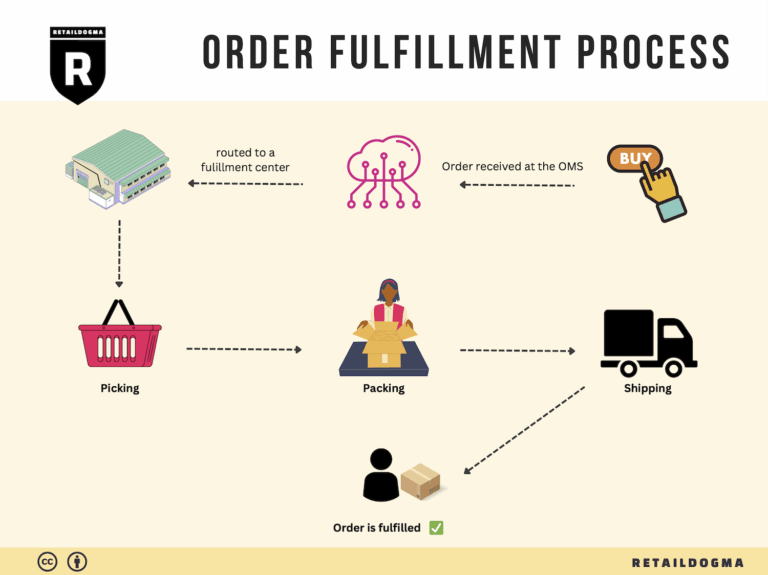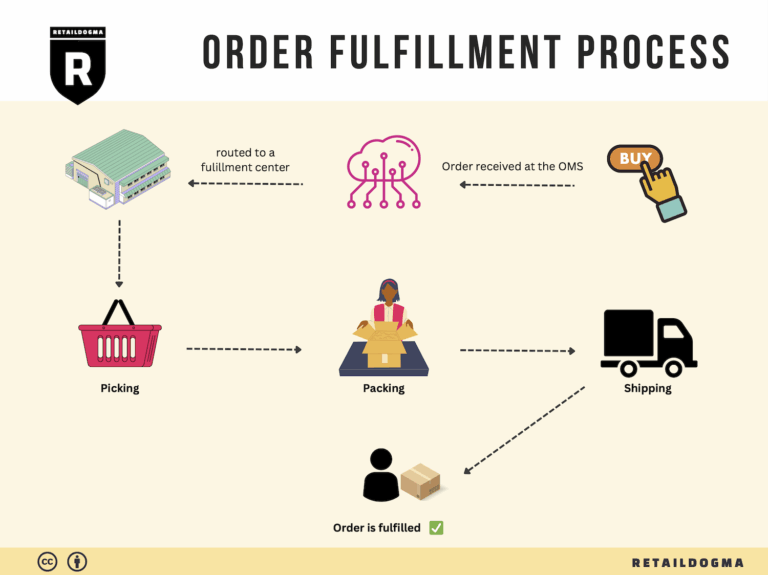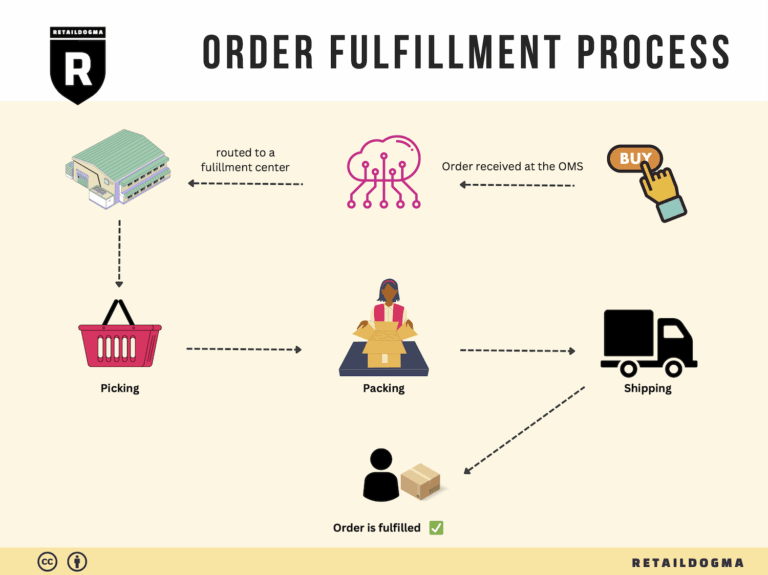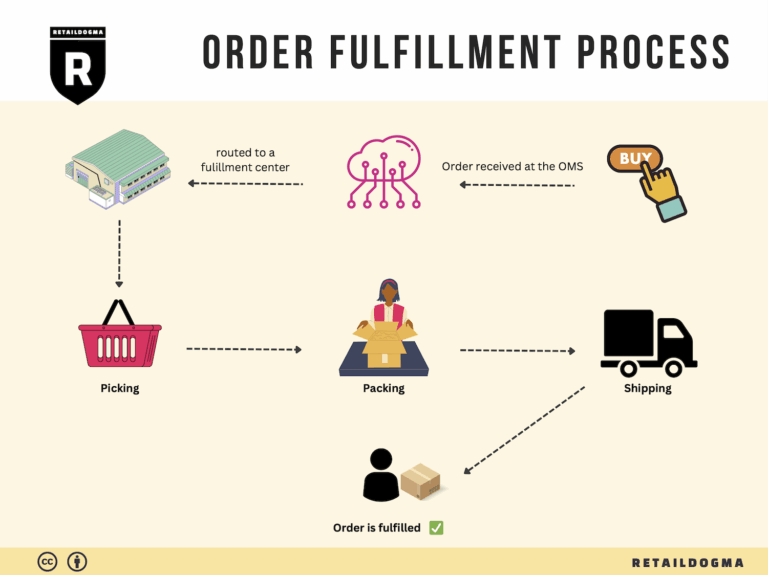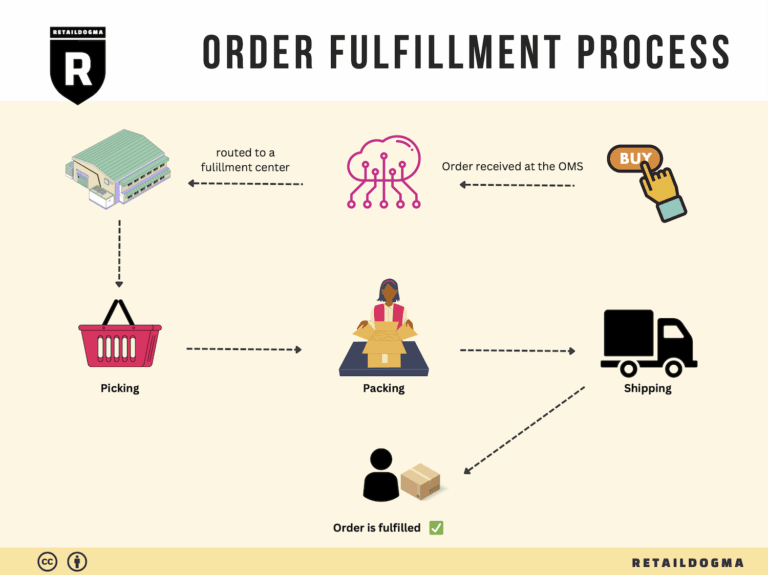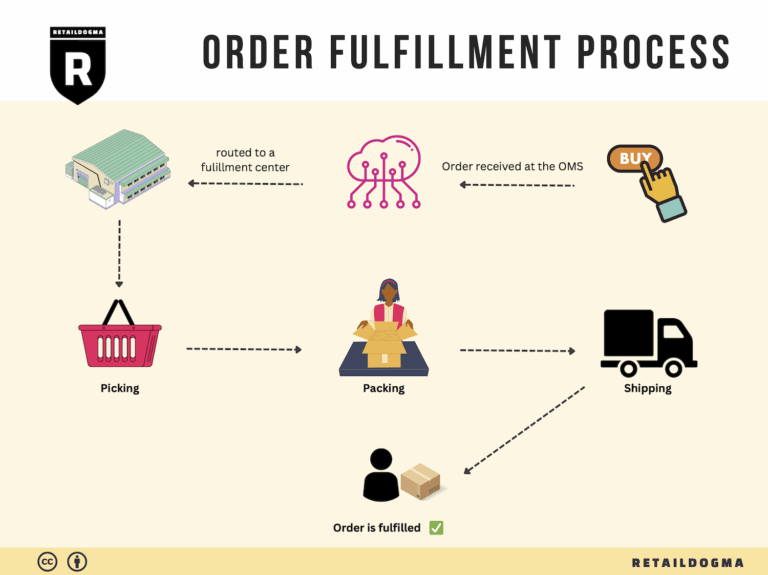What Is A Fulfillment Center? A Complete Guide (2025)
What is E-commerce Fulfillment? An Introduction for Growing Businesses
Understanding E-commerce Fulfillment: A Key to Growth
As an e-commerce business owner, you may find yourself grappling with a common challenge: the overwhelming task of packing and shipping orders. What starts as a passion project can quickly turn into a logistical nightmare, consuming precious time and resources that could be better spent on scaling your business. This is where e-commerce fulfillment comes into play. Simply put, fulfillment is the process of getting a product from your inventory to your customer’s doorstep. It encompasses everything from warehousing and inventory management to packing, shipping, and handling returns.
In this guide, we aim to demystify the world of e-commerce fulfillment and provide you with actionable insights to streamline your operations. We will explore various fulfillment models, including Fulfillment by Amazon (FBA) and third-party logistics (3PL), each offering unique advantages tailored to different business needs.
Different Fulfillment Models
Choosing the right fulfillment model is crucial for your business’s success. We will delve into the specifics of FBA, where Amazon takes care of storage, packing, and shipping, allowing you to leverage their vast network and expertise. Conversely, we’ll look at 3PL providers, who offer a more personalized approach, often accommodating unique shipping requirements and specialized inventory management.
Core Services
Understanding the core services offered by fulfillment partners is essential. We will break down these services, which typically include inventory storage, order processing, shipping logistics, and customer service. Knowing what to expect from your fulfillment partner can help you maintain quality control and enhance customer satisfaction.
Choosing the Right Partner
Selecting the right fulfillment partner can make or break your logistics strategy. This guide will provide practical tips on evaluating potential partners, including factors such as technology integration, scalability, customer service, and pricing structures.
Understanding Pricing
One of the most daunting aspects of e-commerce fulfillment is understanding the pricing landscape. We will clarify the various fees associated with different fulfillment models, helping you assess the total cost of doing business with each option.
Empowering Smart Decisions
Our goal is to empower you with the knowledge and tools necessary to make informed decisions about your logistics strategy. By understanding the nuances of e-commerce fulfillment, you can focus on what truly matters: growing your business and delighting your customers. Whether you’re just starting out or looking to refine your existing processes, this guide will serve as a valuable resource on your journey to fulfillment excellence.

What You’ll Learn In This Guide
- What is E-commerce Fulfillment? An Introduction for Growing Businesses
- The Order Fulfillment Process: From ‘Buy’ Button to Customer’s Door
- Comparing Fulfillment Models: In-House vs. 3PL vs. Dropshipping
- A Deep Dive into Amazon FBA: Pros, Cons, and Who It’s For
- Core Services Offered by Fulfillment Centers
- How to Choose a Fulfillment Partner: A 6-Point Checklist
- Understanding Fulfillment Pricing: A Breakdown of Common Fees
- Frequently Asked Questions (FAQs) about Fulfillment
- Conclusion: Is Outsourcing Fulfillment the Right Move for Your Business?
- Important Disclaimer
The Order Fulfillment Process: From ‘Buy’ Button to Customer’s Door
1. Receiving Inventory
The order fulfillment process begins with receiving inventory from suppliers. This step involves checking the quantity and quality of the products against the purchase orders. Each product is assigned a unique Stock Keeping Unit (SKU), which helps in tracking inventory levels and managing stock efficiently.
Importance: Proper inventory receiving ensures that businesses maintain accurate stock levels, which is crucial for meeting customer demand. Discrepancies in received inventory can lead to stockouts or overstock situations, both of which negatively impact sales and cash flow.
Key Term: SKU (Stock Keeping Unit) – A unique identifier for each product that facilitates inventory tracking and management.
2. Warehouse Storage
Once the inventory is received and verified, it is then organized and stored in designated areas within the warehouse. Efficient warehouse storage involves categorizing products based on their types, sizes, and sales velocity. This organization can include shelves, bins, or pallets, depending on the nature of the products.
Importance: Effective storage solutions minimize the time spent locating products, thus enhancing overall operational efficiency. A well-organized warehouse can significantly reduce order processing times, leading to quicker fulfillment and improved customer satisfaction.
Key Term: Bin Location – A specific storage space assigned to a product in the warehouse, facilitating easy identification and retrieval.

3. Order Picking
When a customer places an order, the next step is order picking, where warehouse staff retrieve the items from their storage locations. This process often utilizes pick lists, which detail the items and their respective locations within the warehouse. Depending on the order volume and warehouse setup, businesses may employ various picking methods, such as batch picking, wave picking, or zone picking.
Importance: Efficient order picking is critical for minimizing errors and ensuring that customers receive the correct products. A streamlined picking process can reduce labor costs and improve order turnaround times, which are vital for maintaining a competitive edge in e-commerce.
Key Term: Pick List – A document or digital representation that outlines the items to be picked for a specific order, including their locations.
4. Order Packing
After picking the items, the next step is order packing. This involves securely packaging the products to protect them during transit. Packing materials can include boxes, bubble wrap, and packing peanuts, which help prevent damage. The packing process also includes labeling packages with shipping information and any necessary documentation.
Importance: Proper packing is essential not only for protecting the products but also for optimizing shipping costs. Overly large or heavy packages can lead to increased shipping fees, which can erode profit margins. Effective packing also contributes to customer satisfaction, as well-packaged products enhance the unboxing experience.
Key Term: Packing Slip – A document included in the package that lists the items contained within, serving as a receipt for the customer.
5. Shipping & Delivery
The final step in the order fulfillment process is shipping and delivery. Once packed, orders are dispatched to shipping carriers, who transport them to customers’ doorsteps. This stage involves selecting the appropriate shipping method based on cost, speed, and customer preference. Tracking information is usually provided to customers, allowing them to monitor their order’s journey.
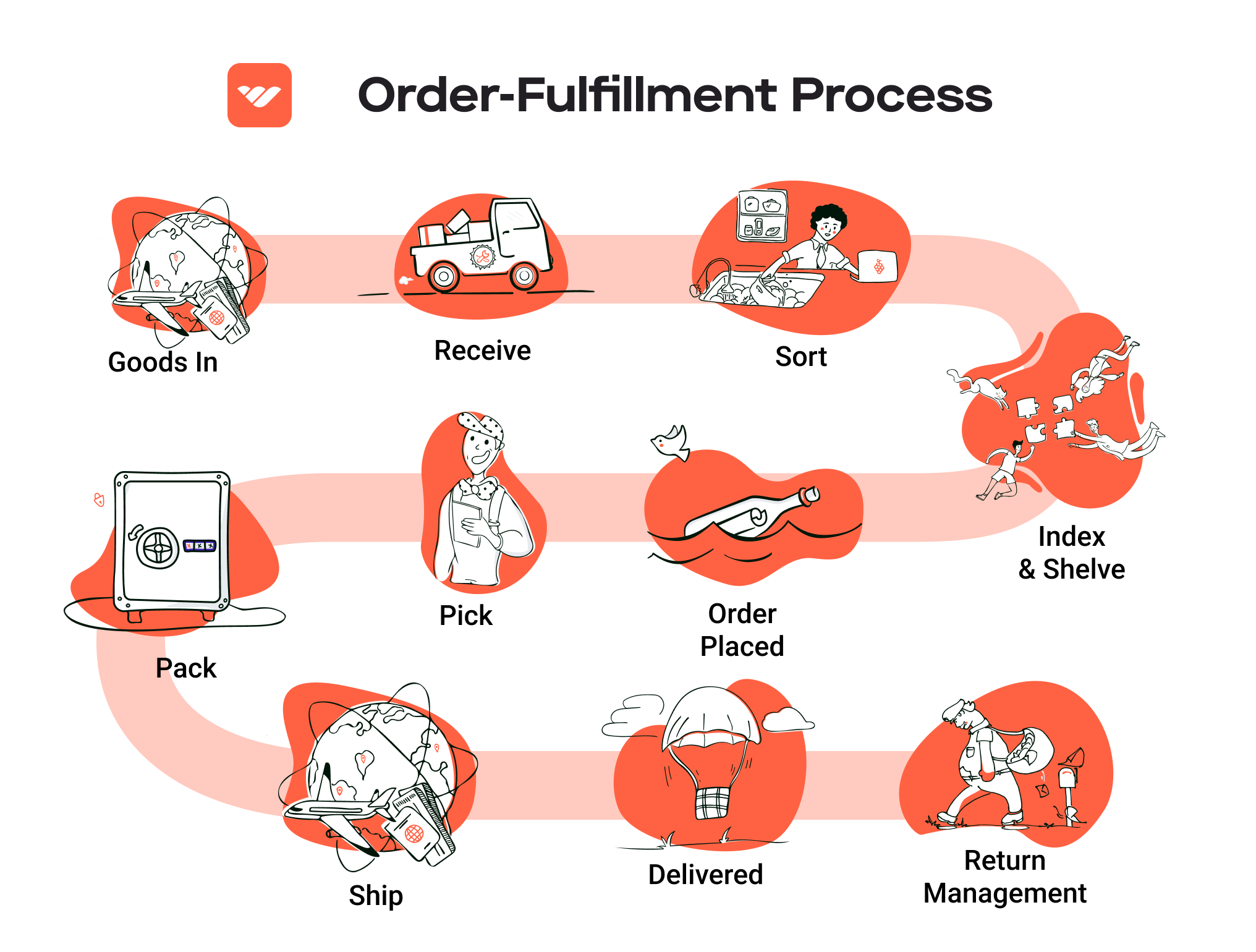
Importance: Timely and accurate shipping is crucial for customer satisfaction and retention. Delays or issues during the shipping process can lead to negative reviews and lost sales opportunities. By optimizing shipping strategies and leveraging partnerships with reliable carriers, businesses can enhance their overall fulfillment performance.
Key Term: Last Mile Delivery – The final step of the shipping process where the package is delivered from the distribution center to the customer’s doorstep, often considered the most crucial and costly part of the logistics chain.
In conclusion, understanding the order fulfillment process is vital for e-commerce business owners and operations managers looking to scale effectively. By optimizing each step—from receiving inventory to final delivery—businesses can enhance efficiency, reduce costs, and improve customer satisfaction, ultimately driving growth in a competitive market.
Comparing Fulfillment Models: In-House vs. 3PL vs. Dropshipping
Fulfillment Models Comparison
| Model | Who Handles Inventory | Best For (Business Stage) | Key Advantage | Key Disadvantage |
|---|---|---|---|---|
| In-House Fulfillment | Business (Owner/Staff) | Established businesses with stable sales | Full control over inventory and shipping | High upfront costs and operational complexity |
| Third-Party Logistics (3PL) | Third-party provider | Growing businesses scaling operations | Access to expertise and scalability | Less control over the fulfillment process |
| Dropshipping | Supplier | Startups and low-capital businesses | Low initial investment and risk | Lower profit margins and less control over stock |
In-House Fulfillment
In-house fulfillment involves managing the entire supply chain process within your own business. This includes storing inventory, packing orders, and shipping them directly to customers. It is typically best suited for established businesses that have a consistent sales volume and can afford the overhead costs associated with maintaining a warehouse and staff.
One of the key advantages of in-house fulfillment is the complete control it provides over the inventory and shipping process. Businesses can ensure the quality of packaging, the speed of delivery, and can respond quickly to customer inquiries. However, this model also comes with significant disadvantages. The initial investment can be substantial due to the costs of warehousing, staffing, and logistics technology. Additionally, as order volumes increase, the operational complexity can lead to inefficiencies and higher labor costs, which may detract from the overall profitability of the business.
Third-Party Logistics (3PL)
Third-party logistics (3PL) refers to outsourcing your fulfillment needs to a specialized logistics provider. 3PL companies handle a variety of services including warehousing, inventory management, order fulfillment, and shipping. This model is ideal for growing businesses looking to scale operations without the burden of managing logistics in-house.
The primary advantage of using a 3PL is the access to expertise and advanced technology that these providers bring to the table. They often have established systems for inventory management, shipping, and returns, which can streamline operations and reduce costs over time. Additionally, 3PLs can scale with your business, allowing you to expand into new markets without the logistical headaches. However, a notable disadvantage is the reduced control over the fulfillment process. Businesses rely on the 3PL to maintain quality and efficiency, which can lead to potential issues if the provider does not meet expectations.
Dropshipping
Dropshipping is a fulfillment model where the retailer does not keep goods in stock but instead transfers customer orders directly to a supplier, who then ships the products directly to the customer. This model is particularly appealing for startups or businesses with limited capital, as it requires very little upfront investment in inventory.
The key advantage of dropshipping is the minimal financial risk involved. Since you don’t need to purchase inventory upfront, you can offer a wide range of products without the burden of managing stock. This model also allows for flexibility, as businesses can quickly adapt their product offerings based on market demand. However, dropshipping comes with its own set of challenges. Profit margins are typically lower compared to other fulfillment methods, as suppliers often charge higher prices for handling logistics. Moreover, businesses have less control over inventory and shipping times, which can lead to customer dissatisfaction if suppliers fail to deliver on time or if products are out of stock.
Conclusion
Choosing the right fulfillment model is crucial for scaling your e-commerce business effectively. Each model—In-House, 3PL, and Dropshipping—offers distinct advantages and disadvantages that should be carefully considered based on your business stage, operational capabilities, and financial resources. By aligning your fulfillment strategy with your business goals, you can enhance efficiency, improve customer satisfaction, and ultimately drive growth.
A Deep Dive into Amazon FBA: Pros, Cons, and Who It’s For
Understanding Fulfillment by Amazon (FBA)
Fulfillment by Amazon (FBA) is a service that allows sellers to store their products in Amazon’s fulfillment centers, where Amazon takes care of storage, packaging, and shipping. This service is particularly advantageous for e-commerce businesses looking to scale operations without the overhead of managing logistics. When a customer places an order, Amazon handles the entire fulfillment process, including shipping and customer service, which can significantly streamline operations for sellers.
How FBA Works
-
Inventory Storage: Sellers ship their products to Amazon’s warehouses. Once received, Amazon manages the inventory, ensuring that products are available for customers.
-
Order Fulfillment: When a customer places an order, Amazon’s fulfillment center picks, packs, and ships the product on behalf of the seller. This process is often faster than traditional shipping methods, especially for Prime members.
-
Customer Service: Amazon also handles customer inquiries and returns, providing a level of service that can enhance customer satisfaction and trust in the seller’s brand.
-
Multi-Channel Fulfillment: Sellers can use FBA to fulfill orders from their own websites or other sales channels, not just those made on Amazon. This feature allows for a more integrated approach to e-commerce.
Pros of Using FBA
-
Prime Eligibility: Products fulfilled through FBA automatically become eligible for Amazon Prime, providing sellers with access to millions of Prime members who prefer fast and free shipping options. This can lead to increased sales and higher visibility.
-
Customer Trust: When sellers use FBA, they benefit from Amazon’s reputation for reliability and customer service. Customers are often more willing to purchase products that are fulfilled by Amazon due to the assurance of quality service and easy returns.
-
Multi-Channel Fulfillment: FBA allows sellers to fulfill orders not only from Amazon but also from their own websites or other platforms. This flexibility can streamline operations and reduce the complexity of managing multiple fulfillment systems.
-
Scalability: For businesses looking to grow, FBA provides a way to scale operations without having to invest heavily in logistics infrastructure. Amazon handles everything from storage to shipping, allowing sellers to focus on other aspects of their business.
-
Time-Saving: By outsourcing fulfillment to Amazon, sellers can save time and resources that would otherwise be spent on packing, shipping, and handling customer service inquiries.
Cons of Using FBA
-
High Fees: While FBA can simplify logistics, it comes at a cost. Sellers must pay various fees, including fulfillment fees based on the size and weight of the products, storage fees for holding inventory, and referral fees for each sale. These costs can add up quickly, impacting profit margins.
-
Strict Inventory Rules: Amazon has stringent inventory management policies. Sellers must adhere to guidelines regarding inventory levels, labeling, and packaging. Failure to comply can result in additional fees or even account suspension.
-
Commingling Risks: FBA products may be commingled with similar items from other sellers, which means that a seller may not always ship their own product. This can lead to issues such as counterfeit products being shipped or incorrect items being sent to customers, which can harm the seller’s reputation.
-
Limited Control: By using FBA, sellers relinquish a degree of control over the fulfillment process. This can be concerning for businesses that prioritize personalized packaging or specific shipping methods.
-
Inventory Management Challenges: Sellers must manage their inventory effectively to avoid stockouts or excess inventory, both of which can incur additional fees or negatively impact sales.
Who is FBA Best For?
Fulfillment by Amazon is ideal for:
-
Small to Medium-Sized Businesses: Companies looking to scale without investing heavily in logistics can benefit from FBA’s streamlined fulfillment process.
-
New Sellers: Entrepreneurs who are just starting out may find FBA a convenient option to enter the market without the complexities of managing their own fulfillment.
-
Sellers with High Sales Volume: Businesses that experience high sales volumes, especially during peak seasons, can leverage FBA to ensure timely order fulfillment and customer satisfaction.
-
Brands Seeking Amazon Presence: Brands wanting to establish a strong presence on Amazon and reach a wider audience can utilize FBA’s capabilities to enhance visibility and sales.
-
Multi-Channel Sellers: Businesses that sell on multiple platforms can use FBA to simplify their fulfillment process, allowing them to focus on marketing and sales strategies rather than logistics.
In conclusion, Fulfillment by Amazon offers significant benefits for e-commerce businesses, but it is essential to weigh these against the potential drawbacks. Understanding the structure of FBA, including its costs and operational requirements, will help sellers make informed decisions about whether it aligns with their business goals.
Core Services Offered by Fulfillment Centers
Inventory Management & Warehousing
Inventory management and warehousing are foundational services provided by fulfillment centers. This involves the systematic tracking of products from the moment they arrive at the warehouse until they are shipped out to customers. Fulfillment centers use advanced inventory management systems that integrate with e-commerce platforms, allowing for real-time tracking of stock levels, order fulfillment rates, and product performance.
Benefits:
1. Optimized Storage Solutions: Fulfillment centers are designed to maximize storage efficiency, utilizing various storage methods such as pallet racking and shelf storage. This not only keeps costs down but also ensures that products are easily accessible when needed.
2. Accurate Inventory Data: E-commerce businesses benefit from real-time visibility into their inventory levels, helping to avoid stockouts or overstock situations. This data-driven approach enables better demand forecasting and inventory planning.
3. Scalability: As your business grows, fulfillment centers can easily adjust storage space and management processes to accommodate increased inventory without the need for significant capital investment in physical infrastructure.
Pick and Pack Services
Pick and pack services refer to the process of selecting (picking) items from inventory and preparing (packing) them for shipment. Fulfillment centers employ efficient systems and trained staff to ensure that orders are accurately fulfilled, often using technology to streamline the process.
Benefits:
1. Speed and Accuracy: Fulfillment centers are equipped with optimized workflows and technology such as barcode scanning, which enhances the speed and accuracy of order processing. This leads to faster shipping times and fewer errors, which are critical for maintaining customer satisfaction.
2. Custom Packaging Options: Many fulfillment centers offer custom packaging solutions, allowing businesses to brand their products effectively and create a positive unboxing experience for customers. This can enhance customer loyalty and encourage repeat purchases.
3. Volume Handling: As e-commerce businesses scale, the volume of orders can fluctuate significantly. Fulfillment centers are well-equipped to handle these variations, ensuring that all orders, regardless of size, are managed efficiently.
Kitting and Assembly
Kitting and assembly services involve grouping individual items into ready-to-ship sets or assembling products before they are sent to customers. This service is particularly beneficial for businesses that sell products that are often bundled together or require assembly.
Benefits:
1. Enhanced Product Offerings: By offering kitted products, e-commerce businesses can create attractive bundles that may appeal to customers looking for convenience or savings, thus increasing average order value.
2. Reduced Time to Market: Kitting and assembly at fulfillment centers can significantly reduce the time it takes to bring a new product to market. Instead of managing this process in-house, businesses can rely on fulfillment centers to handle it efficiently.
3. Focus on Core Business Activities: By outsourcing kitting and assembly, e-commerce owners can focus more on strategic activities such as marketing, product development, and customer service rather than the logistical complexities of product preparation.
Returns Management (Reverse Logistics)
Returns management, or reverse logistics, is the process of handling returned products. Fulfillment centers provide comprehensive solutions for managing returns, including receiving, inspecting, restocking, or disposing of items as necessary.
Benefits:
1. Streamlined Returns Process: A well-managed returns process is crucial for maintaining customer satisfaction. Fulfillment centers typically have established procedures for efficiently processing returns, which can lead to quicker refunds and exchanges for customers.
2. Data Insights: By analyzing return data, e-commerce businesses can gain valuable insights into product performance, customer preferences, and potential issues with specific items. This information can inform product development and inventory decisions.
3. Cost Efficiency: Managing returns in-house can be resource-intensive. By leveraging the expertise of fulfillment centers, businesses can reduce operational costs associated with returns, ensuring that they remain profitable even when handling returns.
In summary, partnering with a fulfillment center allows e-commerce businesses to focus on growth and customer engagement while relying on expert logistics support for inventory management, order fulfillment, product preparation, and returns handling. This strategic partnership is essential for scaling operations effectively in the competitive e-commerce landscape.
How to Choose a Fulfillment Partner: A 6-Point Checklist
Location & Warehouse Network
Importance:
The geographical location of your fulfillment partner is crucial for efficient shipping and delivery. A partner with strategically located warehouses can minimize shipping times and costs, enhancing customer satisfaction.
Questions to Ask:
– Where are your warehouses located, and how do they align with my target markets?
– Do you have a network of warehouses that can support multi-channel fulfillment?
– How do you handle shipping during peak seasons or emergencies?
Technology & Integrations
Importance:
In today’s digital marketplace, robust technology is essential for seamless operations. A partner that offers advanced technology solutions can help streamline your inventory management, order processing, and tracking.
Questions to Ask:
– What technology platform do you use for order management and inventory tracking?
– Can your systems integrate with my existing e-commerce platform (e.g., Shopify, WooCommerce, Amazon)?
– Do you provide real-time data and analytics to help me monitor performance?
Specializations (e.g., Cold Storage, Oversized Items)
Importance:
Different products require different handling and storage solutions. If you sell specialized items, such as perishables or large products, you need a fulfillment partner with the right capabilities.
Questions to Ask:
– Do you have experience handling my specific product types (e.g., perishable goods, oversized items)?
– What special facilities or equipment do you have to accommodate these needs?
– Can you provide references from other clients with similar product lines?
Scalability & Capacity
Importance:
As your business grows, your fulfillment needs will change. A partner that can scale with you ensures that you won’t face capacity issues during peak seasons or when launching new products.
Questions to Ask:
– How do you manage seasonal fluctuations in order volume?
– What is your maximum capacity for handling orders, and how quickly can you scale up?
– Do you have a plan in place for emergency situations that require rapid scaling?
Pricing and Contracts
Importance:
Understanding the pricing structure and contract terms is essential to avoid unexpected costs that can eat into your margins. Transparency in pricing will help you budget effectively and determine profitability.
Questions to Ask:
– What is your pricing model (e.g., per order, per item, monthly fees)?
– Are there any hidden fees I should be aware of (e.g., for returns, storage, or special handling)?
– What are the terms of your contract, and is there flexibility for adjustments as my business grows?
Customer Support & Reviews
Importance:
Reliable customer support is essential for resolving issues quickly and maintaining smooth operations. Partnering with a fulfillment provider that has a strong reputation for customer service can save you time and headaches.
Questions to Ask:
– What kind of customer support do you offer (e.g., 24/7 support, dedicated account manager)?
– Can you provide case studies or testimonials from existing clients?
– How do you handle issues such as shipping errors or damaged goods?
Conclusion
Choosing the right fulfillment partner is a critical decision that can significantly impact your e-commerce business’s success. By using this checklist, you can ensure that your potential partner meets your specific needs and aligns with your growth strategy. Always remember to conduct thorough due diligence, request references, and trust your instincts when making your final selection.
Understanding Fulfillment Pricing: A Breakdown of Common Fees
Initial Setup Fees
When you decide to utilize a fulfillment service, the first cost you’ll encounter is the initial setup fee. This fee is often charged by fulfillment centers to onboard your business, which includes setting up your account, integrating your e-commerce platform, and establishing processes for inventory management. The amount can vary widely based on the fulfillment provider and the complexity of your setup. Some fulfillment centers may waive these fees for larger clients or those committing to long-term contracts.
To get an accurate quote, consider the specific features you need—such as customized packaging or software integration—and inquire about any potential discounts for bulk setups or long-term commitments.
Receiving Fees
Receiving fees are charged when your inventory arrives at the fulfillment center. These fees cover the labor and resources required to inspect, sort, and store your products. Typically calculated on a per-pallet or per-sku basis, the receiving fee can vary depending on the complexity of the receiving process. For instance, if your products require additional handling due to size, weight, or fragility, you may incur higher fees.
When negotiating receiving fees, ensure to clarify what the receiving process includes. Some providers might charge extra for special handling, while others may have a flat fee regardless of product specifics. Always ask for a breakdown of these costs upfront to avoid surprises.
Storage Fees (per pallet/bin)
Storage fees are incurred for the space your inventory occupies within the fulfillment center. These fees can be calculated on a per-pallet or per-bin basis, depending on how your products are stored. Storage fees are typically assessed monthly and can vary based on the size and weight of your products. For example, standard-sized items may have lower storage fees compared to oversized or bulky items.
To manage storage costs effectively, you should keep a close eye on your inventory turnover rate. Excessive inventory can lead to high storage fees, especially if it remains unsold for long periods. Some fulfillment centers also impose long-term storage fees for items that stay in their facilities beyond a certain timeframe, so it’s crucial to stay proactive about inventory management.
Pick & Pack Fees (per item/order)
Pick and pack fees are charged for the labor involved in retrieving items from storage and packaging them for shipment. This fee is usually calculated on a per-item or per-order basis, which means that larger orders with multiple items may incur higher costs. The complexity of the packaging, such as custom boxes or special materials, can also influence this fee.
To minimize pick and pack fees, consider streamlining your inventory so that your best-selling items are easily accessible. Additionally, some fulfillment providers offer tiered pricing based on order volume—meaning that as your order volume increases, the per-item fee may decrease. Always inquire about potential volume discounts and any additional charges for special packaging requirements.
Shipping Fees
Shipping fees are incurred when your orders are dispatched from the fulfillment center to your customers. These fees can vary based on several factors, including the shipping method (standard, expedited, etc.), destination, and weight of the package. Fulfillment centers often have partnerships with shipping carriers, which can lead to more competitive rates for their clients.
To secure the best shipping rates, it’s essential to understand your customer base and shipping needs. For instance, if you predominantly ship to a specific region, you may negotiate better terms for that area. Additionally, some fulfillment services provide tools to help you choose the most cost-effective shipping options for each order, so be sure to explore those resources.
Conclusion: Tips for Getting an Accurate Quote
Obtaining an accurate quote for fulfillment services requires a comprehensive understanding of your business needs. Here are some practical tips to ensure you get the best deal:
-
Provide Detailed Information: Share specifics about your product types, order volumes, and special handling requirements with potential fulfillment partners. The more information you provide, the more accurate the quote will be.
-
Request Itemized Quotes: Ask for a detailed breakdown of all fees, including setup, receiving, storage, pick & pack, and shipping fees. This transparency will help you compare different providers effectively.
-
Consider Long-Term Contracts: If you anticipate significant order volumes, inquire about discounts for long-term commitments. Many fulfillment centers offer lower rates for clients who commit to extended agreements.
-
Negotiate: Don’t hesitate to negotiate terms and rates. Fulfillment centers often have flexibility in pricing, especially for clients who are bringing them significant business.
-
Monitor Your Costs: After partnering with a fulfillment center, keep an eye on your fees and assess whether they align with your expectations. Regular reviews can help you identify areas for cost savings.
By understanding these common fulfillment pricing models and employing strategic negotiation tactics, you can optimize your fulfillment costs as you scale your e-commerce business.
Frequently Asked Questions (FAQs) about Fulfillment
1. What are Amazon FBA fulfillment rates?
Amazon FBA (Fulfillment by Amazon) fulfillment rates are fees charged to sellers for storing, picking, packing, and shipping their products through Amazon’s fulfillment centers. These rates vary based on the size and weight of the items, and they are subject to periodic adjustments by Amazon, such as those announced for 2024.
2. How are Amazon FBA fees structured?
FBA fees are generally divided into two categories: fulfillment fees and storage fees. Fulfillment fees are charged based on the dimensions and weight of the products sold, while storage fees are incurred for the space your inventory occupies in Amazon’s warehouses, billed monthly.
3. What is the difference between standard and oversized items in FBA?
Standard-sized items are typically those that weigh less than 2 lbs and fit within specific dimensional limits. Oversized items exceed these limits and incur higher fulfillment and storage fees. Amazon has introduced more granular fee structures for these categories to better align costs with the actual handling and storage requirements.
4. How do I calculate my Amazon FBA fees?
You can estimate your Amazon FBA fees using tools like Jungle Scout’s FBA Fee Calculator. This calculator allows you to input your product details, including size, weight, and selling price, to provide a breakdown of potential fees, including referral and fulfillment costs.
5. Are there any additional fees for using Amazon FBA?
Yes, besides standard fulfillment and storage fees, sellers may encounter additional costs such as long-term storage fees for inventory held beyond a certain period, removal fees for returned items, and disposal fees if you choose to dispose of unsold inventory.
6. What is the difference between a warehouse and a fulfillment center?
A warehouse is primarily a storage facility for goods, while a fulfillment center is specifically designed to manage the entire process of order fulfillment, including inventory management, picking, packing, and shipping. Fulfillment centers often leverage technology and logistics expertise to optimize the shipping process.
7. What is a 3PL, and how does it relate to Amazon fulfillment?
A 3PL, or third-party logistics provider, is a company that offers logistics services, including storage, warehousing, and distribution. While Amazon FBA is a fulfillment service offered by Amazon itself, some sellers may choose to use a 3PL for flexibility, cost-effectiveness, or to manage inventory outside of Amazon’s ecosystem.
8. How much do fulfillment services cost outside of Amazon FBA?
Fulfillment service costs outside of Amazon FBA can vary widely based on the provider, services offered, and geographic location. Generally, costs may include storage fees, picking and packing fees, shipping costs, and additional service fees for returns or special handling. It’s important to compare multiple providers to find the best fit for your business needs.
9. Will my fulfillment fees change during peak seasons?
Yes, Amazon typically adjusts fulfillment fees during peak seasons, such as the holiday shopping period. For example, from October 15 to January 14, increased fees for Multi-Channel Fulfillment (MCF) orders may apply. Sellers should plan accordingly to account for these fluctuations in their pricing and inventory strategies.
10. How can I minimize my Amazon FBA fees?
To minimize FBA fees, sellers can take several approaches: optimize inventory levels to avoid long-term storage fees, use smaller and lighter packaging to reduce fulfillment costs, and regularly review and adjust pricing strategies based on current fee structures. Additionally, utilizing Amazon’s inventory health reports can provide insights into performance and areas for cost savings.
Conclusion: Is Outsourcing Fulfillment the Right Move for Your Business?
Evaluating the Benefits of Outsourcing Fulfillment
Outsourcing fulfillment can be a transformative decision for e-commerce businesses aiming for growth. One of the most significant advantages is the time savings it offers. By delegating order processing, inventory management, and shipping logistics to a fulfillment partner, business owners can redirect their focus toward strategic initiatives, such as marketing, product development, and customer engagement. This shift in focus can drive revenue growth and enhance customer satisfaction.
Scalability is another compelling reason to consider outsourcing. As your business expands, so does the complexity of managing logistics. A professional fulfillment service can seamlessly scale operations to accommodate increased order volumes, seasonal spikes, or entry into new markets. This flexibility allows you to respond quickly to changes in demand without the overhead costs associated with managing a larger in-house logistics team.
Additionally, partnering with a fulfillment expert brings specialized knowledge and operational efficiencies that can significantly enhance your service offering. From optimizing shipping routes to reducing delivery times, experienced fulfillment partners leverage their industry expertise to improve your overall logistics strategy, ensuring that you remain competitive.
However, the success of outsourcing fulfillment hinges on selecting the right partner. It’s crucial to assess potential providers based on their capabilities, technology, and alignment with your business goals. A thorough evaluation will ensure that your chosen fulfillment partner can support your growth trajectory effectively.
Call to Action
As you weigh the benefits of outsourcing your fulfillment, take a moment to audit your current shipping processes. Consider whether the efficiency and expertise of a fulfillment partner could enhance your operations and help you scale. If you find areas for improvement, exploring fulfillment options may be your next strategic step toward achieving your business goals.
Important Disclaimer
⚠️ Important Disclaimer
The information in this guide is for educational purposes. Fulfillment services, pricing, and platform features change frequently. Always conduct your own due diligence and consult with providers directly before making business decisions.
